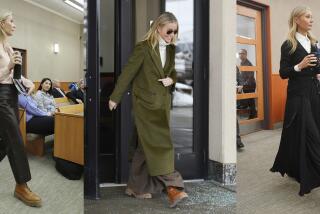Room for opportunity
Like housing, commercial real estate is in a slump -- one that may not bottom out for another year or two as the value of offices, warehouses and malls dwindles.
Falling prices will create profitable opportunities for investors who can raise money to buy discounted property, Los Angeles real estate professionals said, but few buildings are selling and the market will suffer more before it gets better.
Landlords’ pain will be tenants’ gain, however, as rising vacancies pressure owners into lowering rents. Shrinking employment will reduce demand for offices and dump more space on the market at discounted prices.
Owners of all types of commercial real estate including hotels have been smacked by the international credit crunch and financial downturn, said Wayne Ratkovich, chairman of the Los Angeles branch of the Urban Land Institute, an industry trade group. And the grief is widespread.
“It’s a pretty gloomy forecast no matter where you go,” said Ratkovich, who is also a Los Angeles developer and landlord. “It’s hard to find optimism out there.”
The bottom of the market is six to 12 months away, according to almost half of the respondents to a recent Urban Land survey. An additional third of the professionals including developers, lenders, brokers and architects were more bearish, guessing that the bottom could be as far away as two years. Only 2%, though, said it could take longer than two years to start turning around.
Commercial real estate values became overinflated during the recent boom as publicly owned real estate investment trusts, pension funds and other buyers poured money into property acquisitions because they looked like surefire investments, industry observers said. Now fear has replaced greed as the motivating force.
“There is a psychological component to all this,” said Robert Gardner, managing director of real estate consulting firm Robert Charles Lesser & Co. “Exuberance on the upside is being compounded on the downside and markets will overshoot in the other direction.”
Worried lenders have practically locked their vaults for the time being, making financing for buying and building commercial projects extremely difficult to obtain. Funding is scarce even for comparatively modest deals of a few million dollars, unless buyers are willing to make substantial down payments. Large-scale property trades and developments look impossible.
“The mega deal is done” for the time being, Gardner said.
Stalled at the starting line for lack of financing are such mega projects as the $3-billion Grand Avenue residential, retail and hotel complex in downtown Los Angeles and a $400- million luxury condominium tower on the edge of Century City.
The $1-billion Park Fifth residential and hotel complex, another planned downtown Los Angeles mega development, is also on hold awaiting financing.
Other large projects that were funded years ago, such as the $2.5-billion LA Live entertainment, hotel and residential center downtown, are under construction and expected to be completed. A $600-million hotel, residential and retail development being built at the intersection of Hollywood Boulevard and Vine Street in Hollywood should be open next year.
How those projects will fare upon completion remains to be seen, of course, but real estate industry veterans say a market correction, however painful, was due.
The downturn prompted Los Angeles real estate broker Jerry Porter to recall previous commercial real estate slumps that followed sustained periods of escalating prices. A building boom in the 1980s when savings and loans’ largess and favorable tax laws led to an oversupply of office space and other commercial buildings peaked when the economy started to cool in the late 1980s.
Property prices and rents came down and stayed down well into the 1990s, when the Internet boom finally created thousands of new businesses and pushed real estate values up again. It was another bubble in the making, said Porter, chairman of Cresa Partners.
“Dot-com ideas were funded that didn’t have any clear commercial merit,” Porter said, but the rapid growth of new companies drove up office rents and pushed investors to pay ever-increasing amounts for properties to house them.
Then, as in the mid-2000s, investors borrowed heavily to buy real estate on the assumption that there would always be a “greater fool” willing to pay more than they did when it came time to sell. In the boom that just ended, some investors paid more for existing buildings than it would cost to build a new one -- a warning sign of an overheating market.
Those investors felt justified in their spending because land is a finite resource and new projects are difficult to get approved in dense urban areas such as Los Angeles, Porter said. But those rationalizations ring hollow now in the face of shrinking demand from tenants. “A lot of people overpaid,” he said.
After creeping up most of the decade, commercial rents started to slip this year, and experts predict that the slide will continue.
“Usually some markets perform better than others,” said Delores Conway, director of the Casden Economic Forecast at USC, “but demand is weak everywhere.”
After years of gradual tightening in vacancy and rising rents, the market -- of which office space is by far the largest category -- reversed course swiftly in recent months, she said. The culprit, of course, was the meltdown of the credit industry and the ensuing economic havoc.
Struggling white-collar companies have moved quickly to lay off employees, creating empty space in their offices. In a further effort to cut costs, many of those businesses are attempting to sublet their empty space at rates as much as 20% below typical market rents.
Particularly hard hit by the infusion of cheap sublease space have been Orange County, where financial services and real estate companies vacated thousands of square feet, and the Westside, Los Angeles County’s largest market, Conway said.
Westside landlords asked for dramatically increasing rents in recent years because little space was available and some of the biggest landlords had purchased large groups of office buildings at the top of the sales market and needed high rents to make a profit.
Many businesses abandoned the Westside for cheaper office space elsewhere, even if they had to leave pricey rented space behind and sublease it in an effort to cut their real estate costs.
Now about a third of the available office space in West L.A. is sublease space, according to a Casden forecast released last week, Conway said. Vacancy has inched up to about 10% and broker Porter estimated that it might reach 15% over the next two years.
Downtown Los Angeles, the county’s second-largest market, is also under pressure from the economy and the consolidation or disappearance of some large financial firms such as Bear Stearns Cos. that kept offices there.
“Rising vacancy is a welcome relief to tenants and potential buyers,” Conway said. “They can lease more reasonably and have more opportunities to own a building.”
--







